
VOL. II NO. 24 REG NO. L5015 DELHI, THURSDAY FEBRUARY 24, 1944
IN SCOPE, STILWELL ANNOUNCES
Japs Defeated On All Fronts Of Jungle War
BURMA - American-trained Chinese troops this week continued to stalk the Jap in the Hukawng and Dalu Valleys. Wherever and whenever they caught the enemy, the Chinese inflicted casualties out of proportion to their own loses in savage engagements. They maintained the grim impetus of their several drives through the muck of the tight jungle.
And while these heartening things were happening, Lt. Gen. Joseph W. Stilwell disclosed at a press conference that the Chinese offensive has now "been enlarged in scope to take northern Burma."
'HAVE MY SUSPICIONS'
Stilwell said more. "I do not know exactly how strong the Japs are," he declared, "but I have my suspicions and soon will find out for certain. The Japs are playing a delaying game and are fighting stubbornly. But the Chinese know from experience they can beat them and are advancing confidently."
The offensive was more limited when it opened last year on Nov. 1, with the immediate goals now captured Taipha Ga and Taro and the over-all action designed to provide elbow room for the lengthening Ledo Road, which one day will provide a vital line of supply to isolated China from India.
OFFENSIVE MOUNTING
One can liken the mounting Chinese offensive and their will to come to grips with the Jap to a snow ball, growing as it rolls. According to a dispatch by Arch Steele, veteran Chicago Daily News correspondent, "It's amazing what a taste of success and the sight of Japanese dead and Jap prisoners will do for the fighting spirit of Chinese soldiers after years of setbacks and withdrawals against unequal odds on the battlefields of China."
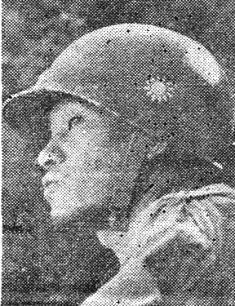 V.M.I. trained Maj. Gen. Sun Li Jen commands the 38th Division which is striking hard at the Japanese in northern Burma.
V.M.I. trained Maj. Gen. Sun Li Jen commands the 38th Division which is striking hard at the Japanese in northern Burma.
|
Latest reports from the Hukawng and Taro (Dalu) Valleys portend doom for many of the retreating Japanese. Elements of Maj. Gen. Liao Yao-Hsiang's 22nd Chinese Division, which had advanced only a few hundred yards a day for three weeks following the fall of Taipha Ga, made a lightning-like thrust covering five miles to snip the Taipha Ga-Maingkwan Road in the vicinity of Tsumhpawng. Remaining elements of a Jap regiment and two or more batteries of artillery are now squeezed into a tight pocket with little hope of escape, and 50 enemy dead were found in the wake of the scramble eastward toward the Wantuk range separating the Hukawng and Dalu Valleys.
Northeast of Taipha Ga, another Chinese column dispersed the enemy at Nzang Ga along the Mawning River, moved southwest into Singlung Ga a day later and then pressed into the Law-awng Ga sector. Only a few miles now separate the Chinese forces from the east and west which are enveloping the important enemy territory south of Taipha Ga.
Meanwhile, remnants of a Jap battalion scurrying from the Taro area are reported as being trapped along the Ahawk River trail, which wriggles scross the spine of the Wantuk range and joins the Taipha Ga-Mainkwan Road near Lakyen Ga. After a bloody pursuit against stubborn enemy delaying action, elements of the Chinese forces have succeeded in a wide and speedy enveloping movement which blocked the Japs retreating in the rear of the column. A slow process of closing in and eliminating the remainder of the enemy force is now in progress.
North of this area, other troops advanced, occupying former Jap positions south of the Chindwin and pocketing the Japs west of Taipha Ga, where many booby traps were uncovered.
Staunchly supporting the Chinese push are both the Air Corps and the Ledo Road. Not only are fighters and fighter-bombers of the Tactical Air Force searching out the Japs and their supply dumps in the jungle, but air-dropping planes of the Troop Carrier Command are also effectively sustaining the offensive with food and supplies.
One air-dropping action enabled an encircled unit of Chinese to hold out for two months, while under similar circumstances, a Japanese force was quickly annihilated.
Meanwhile, the Ledo Road has started to pay dividends. Working 24 hours a day, the Engineers have in the last three months bent their backs to increase it to roughly half the length it is at this writing. By the blaze of diesel oil drums, the work progresses throughout the night and the road is breathing down the neck of the offensive.
Other Engineers have carved out airfields. One of these was constructed in 14 working hours when a ricefield was converted into an air strip by three bulldozers which worked their way over jungle trails to the forward position under shellfire.
A correspondent filed a story recently in which he decided that in three months' fighting the Chinese have defeated and driven back a good part of a Jap division and have advanced 60 air miles into Burma. Well over 1,000 Japs had been killed, he reported, at the time he wired the report to his agency.
Captured Japanese prisoners have been ill fed and ragged, although their equipment has been good. Some surprisingly, have surrendered, but others, like a medical officer trapped in a fox hole, conversed with the Chinese who surrounded him, then blew himself up with a hand grenade.
One prisoner attempted to ingratiate himself with Stilwell by offering to shake hands, but the general refused and delivered a burst of earthy invective. He observed, "They seem to be learning. The best way to bring them around is to kill their pals. That's the kind of language they understand. That's our best propaganda."
Maingkwan appears to be the next principal objective of the Chinese. It is important that this base south of Taipha Ga and est of Taro is taken within the next two months, for showers are already starting to turn the ground to soup and the coming monsoon will make the going infinitely more tedious.
As it is, rain falls intermittently in the jungled valleys and turns trails into soup. Because of the mud, Stilwell's life was probably saved this week when the gooey undergoing minimized the effect of 75mm shells.
UNCLE JOE GETS VALENTINE FROM JAPS
GENERAL CAUGHT IN CONCENTRATION OF SHELLS
BURMA - Lt. Gen. Joseph W. Stilwell received his Valentine from the Japanese early last week when he was caught in the center of a random concentration of 10 enemy 75mm shells while tramping a trail in the Hukawng Valley.
Stilwell, preceded and followed by Chinese, his bodyguard and war correspondents, was caught on a high ground trail. The shells dropped on each side and the front and the rear, covering the column with mud, sticks and flying underbrush.
After the general returned to his base, he estimated that two of the shells had exploded within 10 yards of the column and declared: "If that had been a hard ground, we would have been out of luck.:
As it was, the projectiles buried themselves in the soft mud in such a way that the force of the explosion was generally upward.
When the first shell exploded, Stilwell looked over his shoulder with that characteristic bird-like head gesture and remarked, "Well, a little close." That was the most classic piece of understatement in the history of the Hukawng Valley.
After getting his bodyguard into the slot made by the downward cut of the trail, Uncle Joe yelled at the stragglers to hurry up. When all were in, he called names to make sure, grinned, squatted down and lit a cigarette. Although never hitting the ground, Infantry fashion, the general knelt behind trees and then walked rapidly toward the cut. He did not run.
Among the members of the party was Maj. Fred Eldridge, officer-in-charge of the Roundup. A careful check of all concerned brought the profound consensus that the war was getting rough.
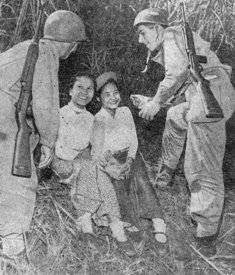 Friendship - strictly platonic - blooms in the jungle as T/Sgt. Tom McGowan and Pvt. George Oehrlein chat with two
nurses of Lt. Col. Gordon S. (Burma Surgeon) Seagrave's hospital unit.
Friendship - strictly platonic - blooms in the jungle as T/Sgt. Tom McGowan and Pvt. George Oehrlein chat with two
nurses of Lt. Col. Gordon S. (Burma Surgeon) Seagrave's hospital unit.
|
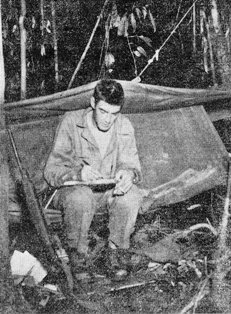 With the jungle backdrop as inspiration, S/Sgt. Charles Stewart sits on his hammock and composes a "sugar report" to
the little lady back home. Love and kisses.
With the jungle backdrop as inspiration, S/Sgt. Charles Stewart sits on his hammock and composes a "sugar report" to
the little lady back home. Love and kisses.
|
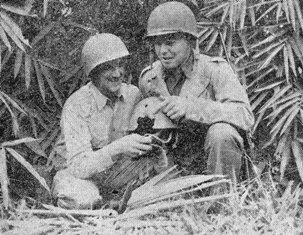 Here's one for the family album, taken somewhere near the Burma-India frontier. Cpl. Jacinth Santos and Cpl.
William Trombley are pictured with a bullet-riddled Japanese helmet.
Here's one for the family album, taken somewhere near the Burma-India frontier. Cpl. Jacinth Santos and Cpl.
William Trombley are pictured with a bullet-riddled Japanese helmet.
|
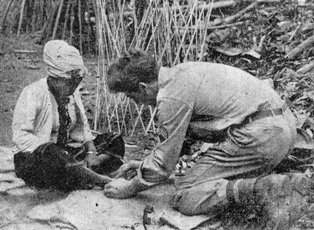 Dem bugs will bite you if you don't watch out, even if you're a Kachin (a local inhabitant). An insect bite infection
is treated by S/Sgt. Alex J. Haggis.
Dem bugs will bite you if you don't watch out, even if you're a Kachin (a local inhabitant). An insect bite infection
is treated by S/Sgt. Alex J. Haggis.
|
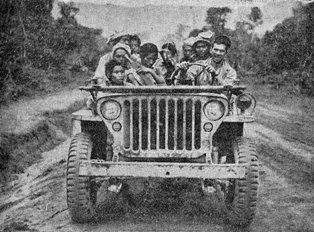 Sgt. Wayne J. Six fufills a promise made to his jungle supply porters. They get a big kick out of clambering aboard
the sergeant's jeep for a Sunday afternoon drive. Relations are friendly between the local inhabitants and the G.I.'s.
Sgt. Wayne J. Six fufills a promise made to his jungle supply porters. They get a big kick out of clambering aboard
the sergeant's jeep for a Sunday afternoon drive. Relations are friendly between the local inhabitants and the G.I.'s.
|
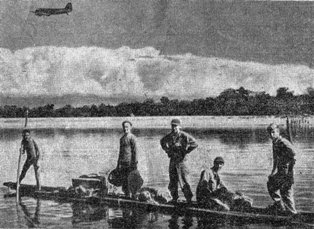 It's a regular Ferryboat Serenade as Pvt. Ludwig Bierl, T/5 John Bessaw, Pvt. William Jewell and Pvt. Noel Manion
ferry supplies across the Tarung River in a dugout. This river empties into the Chindwin, scene of much recent fighting.
It's a regular Ferryboat Serenade as Pvt. Ludwig Bierl, T/5 John Bessaw, Pvt. William Jewell and Pvt. Noel Manion
ferry supplies across the Tarung River in a dugout. This river empties into the Chindwin, scene of much recent fighting.
|
14th A.F. Strikes Hard At Jap Shipping
14TH A. F. HQ. - Bombers and fighters of the 14th Air Force this week concentrated their efforts upon Jap shipping in the Tong King Gulf, railroad bridges and installations in French Indo-China, and airdromes in Burma.
Mitchells, on Feb. 19, bombed and destroyed the railroad bridge at Hatrung, French Indo-China, and scored hits on rolling stock and buildings. Fighter-bombers dive-bombed and destroyed a 2,700-ton enemy merchant vessel off Campha Port, also in French Indo-China, and strafed and destroyed the administration buildings at Mongay airdrome.
2,700-TONNER SUNK
Other fighters strafed the barracks area at Lio Wing airdrome in Burma, doing considerable damage. Other American Mitchells, on a sea sweep, sank a 2,700-ton freighter off Foochow on the China coast.
The day before, Mitchells on a sea sweep off the Tong King Gulf, attacked twp 950-ton cargo boats, probably damaging one, which was left with a large quantity of oil streaming astern. The bombers then destroyed a rail bridge at Phuly, French Indo-China.
VISIT TONG KING GULF
Earlier in the week, planes of the 14th hit shipping in the Tong King Gulf three times, wreaking considerable damage to Japanese shipping. On Feb. 14, fighters strafed the airdrome at Hsenwiin, Burma. Storage sheds were set afire and heavy black smoke was visible.
The next day, Mitchells bombed a 1,200-ton steamer in the Tong King Gulf. The rail station at Haiphong was strafed. On the 17th, Mitchells sank a 1,200-ton freighter in the Tong King Gulf.
1,000 U.S. TROOPS LOST IN SEA WAR
WASHINGTON - The War Department announced this week the sinking of an Allied troopship in Mediterranean waters with the loss of 1,000 American troops. A thousand others were rescued. It was the first tragedy of this magnitude since the start of the war. The sinking occurred at night during a heavy sea on an undisclosed date. The cause was described merely as "enemy action."

|
HELL, HIGH WATER
FAIL TO HALT BIG JOB
It's a little silly to tell United States Army Engineers that a job is impossible. It's especially silly when they are building a road and under the command of a peripatetic old guy like Col. Lewis Pick.
Pick has white hair and didn't develop his sturdy bottom sitting behind desks. He developed it travelling up and down the Ledo Road in a jeep, telling the boys with the hairy ears that they had to get so many miles done that day and damn the rain, the jungle, the mud, the mosquitoes, the mountains and the consequences.
We are not trying to imply that Pick has gone forth like Lancelot in gilded armor, driving the lead bulldozer and challenging his boys to keep up. He probably couldn't drive a bulldozer if he had to. What we are trying to say is that Pick is the guy who puts ants in everyone's pants and delivered an engineering project that must equal in immensity and difficulty any that has ever been attempted by the United States Army.
Pick doesn't live in an ivory tower and neither do the boys whose muscles are actually building what is intended to be a new line of communication into China. These junior officers and men live along the road, on top of saw-tooth ridges, and are quite comfortable now. This, gentle readers, is the "dry" season. It only rains about four days out of five and the guys building the road only get wet on the outside. Later, when the monsoon opens, they'll get wet from sweat and wet from rain and their clothes will never dry out, their shoes will mold, leeches will construct dugouts in their navels, mosquitoes will be as big as B-25's, the mud will be the same only more so, but they'll continue to build the road.
An officer will get an order from Pick to build five miles in 24 hours and he'll say, "What does that damn fool think I am, a magician?" He'll tell his sergeant, who will explain, "I've got four bulldozers. Two haven't got clutches anymore. One is hitting on three cylinders. The other will be busy pushing stuck trucks that are never kept off this God-forsaken boulevard so we can build it."
They'll gripe, curse, say it can't be done, get their T/5 slips and build the five miles. They'll never admit it was possible to build it. They'll alibi that it was done because of some fortuitous circumstance beyond their control and say it can't be done again. The truth is that it will be done again., and again, regardless of circumstances, and one day American trucks with Chinese and American drivers will be rumbling back up the Burma Road to China.
When this road was started, the cynics went to work in earnest. It couldn't be done, they said, and it did undoubtedly falter for a while. Then came reinforcements and Pick. The Americans, Chinese, Indians and assorted tribesmen have already pushed the road ahead at a faster pace than these same cynics ever believed possible. The road has been partially graveled, trucks move ahead, never stopping to permit construction to proceed unhampered.
This road is not the Roosevelt Highway and 15-miles-per-hour speed limit signs make you shake your head and wonder how you can ever go that fast without telescoping your spine. It isn't worth much for Sunday driving in your convertible coupe.
This road is a yellow scar torn through the lush, green jungle and a monument to officers and men who have imagination, who will take a chance, who are tough and who won't be licked by the elements.
STIMSON PROMISES NEW PLANES TO CBI
Following hard on the heels of last week's announcement by Lt. Gen. Joseph W. Stilwell and Maj. Gen. George E. Stratemeyer that additional air transport planes would be furnished to the CBI Theater, Secretary of War Henry L. Stimson reiterated in Washington this week that "the largest and fastest air cargo carriers will be available."
C-47 OUT-WITS JAPANESE ZERO TO WIN IN AERIAL BATTLE
UPPER ASSAM BASE - Visitors to this base often stare in amazement when they pass No. 721, a C-47 Air Transport Command plane with a

|
This unusual achievement was rung up not long ago over Burma, when the supposedly helpless transport plane was attacked by one of the Jap killers of the air. Thinking fast, Lts. Charles (Pat) Lawton of Berkeley, Calif., and George Laben, of Indiana, at the controls, went into a power dive from 4,000 feet to tree-top level in an effort to break away.
This did not succeed, for the Jap followed them leisurely, waiting for the right moment to strike like a hunting hawk at a fat chicken. But, unknown to the Jap, the transport was heading for a valley which dropped sharply for 500 feet just on the other side of a ridge.
The transport hopped the ridge and dropped several hundred feet into the valley, just as the Zero dove for the kill. The hapless Jap pilot, unaware that the valley existed, was unable to come out of his dive after he realized the trick that had been played on him, and flattened his plane (and himself) like a pancake on the ridge.
So that's how innocent-looking No. 721 joined the killer class, and that's why its crew points proudly to the Jap flag on its nose, put there to commemorate perhaps the only victory in the air of an unarmed transport plane over a deadly Zero.
TO DAVY JONES' LOCKER
195,000 TONS OF NIP SHIPS DISPATCHED THERE BY TWO B-25 SQUADRONS
CHINA - Two squadrons of Mitchell medium bombers had sent to the bottom 103 Japanese ships totalling 195,000 tons, up to Feb. 7, it was announced this week by 14th Air Force Headquarters.
The squadrons that set up this number of watery graves for the Nipponese vessels were the "Sky Dragons," which accounted for 73 totaling 113,800 tons, and the "Avengers," who got 30 for a mark of 81,200 tons. These figures do not include ships damaged and probably sunk.
The "Sky Dragons" was the first AAF squadron in China. For many months it was the only bomber unit of the China Air Task Force.
236 COMBAT MISSIONS
Under the command of Lt. Col. Joseph B. Wells, this group of high-flying Yanks has amassed a total of 236 combat missions to blast Jap shipping and support Chinese ground forces.
Thirty-six conformed enemy fighters and 26 probables have been shot down by "Sky Dragon" gunners. T/Sgt. George W. Gouldthrite, who holds the DFC, has shot down five Nip fighters, for top honors.
Together with Chinese-American bombers, the "Sky Dragons" were the first bombers to hit Formosa, with Wells earning the DFC for leading his men on this raid.
The "Avenger" squadron of the Chinese-American Wing went on a bombing spree between Jan. 23-25 off the east and southeast coasts of China to sink 13 Jap ships confirmed and four damaged, for a total of 41,600 tons confirmed sunk.
JAN. 24 'THE DAY'
Jan. 24 turned out to be "the day" for the "Avengers." They sank six ships, including one gunboat, a tender and four medium-sized merchant ships and probably sank a large freighter. Maj. Tom Foley led these attacks, with a personal score of four confirmed sunk and two damaged, accounting for 16,600 tons.
The leading scorers of this squadron are Maj. Foley, six ships confirmed; Lt. Mark Seacrest, six confirmed; Capt. William Carson, five and a half confirmed, and capt. D. B. Harper, two confirmed, in addition to having a float-type Zero to his credit.
Col. Irving L. Branch, commanding officer of the squadron, was recently awarded the DFC for leading the bombers in the attack on Formosa.
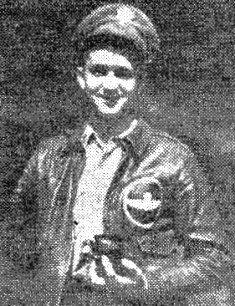
|
MEDIUM BOMBARDMENT SQUADRON, INDIA - Lt. John M. Schrader, veteran navigator for the "Skull and Wings," is probably the first flying man in CBI-land to have a Japanese airfield named after him.
The story dates back to to a recent night mission. Assigned to bomb an important Japanese airport in Burma, the unit Schrader was navigating somehow got off its course and, at the time it was suppoosed to be over the objective, found itself over a newly-constructed but hitherto unknown airfield. But it was a good target, so bombs away and merry hell for the Jap efforts in the next few minutes.
At the interrogation and for the next few days, the story was taken with uplifted eyebrows and the field lightly but politely referred to as "Schrader Field." A check of the co-ordinates offered by Schrader and mates and a thorough scouring of all available Burma enemy airdromes indexes revealed no airfield at that location.
It was not until recon photos arriving from a photo squadron a few days later proved the existence of the field that Schrader's flight began to get credit for a magnificent "blunder" which put out of action and enemy field before it became an accredited target. Around these parts, it is still known as "Schrader Field."
Test Pilot No Stranger To Aerial Danger
ASC BASE, INDIA - At 24, F/O Donald L. Kosteff, now serving as a test pilot for the CBI Air Service Command is no Johnny-come-lately at the grim business of aerial warfare. His new job, while packed with hazard, is strictly a lead-pipe cinch compared
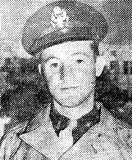
|
Now he looks back on those death-laden days and comments, "It's all right for young men, but you age awfully fast up there in those heavenly realms." He's satisfied to have five and one half Jerries to his credit.
During the Battle of Britain, Kosteff, then 21, got his first taste of combat in large doses. He was too busy to put specific value on his life. He was shot down once at Heston on the outskirts of London; it was a murky night; he landed hard; but got up and walked away. During the raids on the English capital, he knocked down four Nazis and collaborated in bagging a fifth for a half credit.
Late in the fall of 1941, he was assigned to form the First Spitfire Squadron for service in the Middle East, where he arrived in the spring of '42 in time for Herr Rommel's big push into El Alamein. Over the Suez he scored another credit when he downed a Heinkel 111.
Kosteff's most unforgettable moment however, was at Tobruk. He was one of the last two men to leave the seathing port, having remained behind to blow up a gasoline dump. He hopped into a Hurricane, a ship he never piloted before. As he puts it, "I learned how fast." Tanks and anti-aircraft banged away at him as he took off, and, when he landed, he discovered that the right wing tanks, the oxygen rig-up and the hydraulic system had been shot away.
It was a daily retreat from then on, but the Nazis came at night, too, dropping flares and encores of bombs. A fragment of one of these tore into his leg and it was five days before he got to a doctor.
His last five months with the RAF, he was assigned to test flying.
CBI Negro Units Make Contact With Japanese
ADVANCED BASE, NORTHERN BURMA - American colored troops, already noted in the CBI Theater for their yeoman construction work on the Ledo Road, are now getting their first taste of brushes with the Japs in the current Hukawng Valley operations - and are doing very well, thank you.
Typical of these is Roy Lee Smith, formerly of Lexington, Ky., now a member of a colored pontoon unit and operator of one of the flat-bottomed boats that ply the forest-lined rivers of northern Burma with men, cargoes, supplies and Chinese wounded. Smith already has had two brushes with death, in one of which he saved the lives of two Chinese comrades, but he remains modestly unimpressed with himself as a hero.
BOAT OVERTURNS
One of these came when the boat he was handling sank in the swift waters of the Chindwin River. Of its occupants, five - three American Negroes and two Chinese - went down in the boiling current and never came up. Smith however, in spite of the weight of his soggy uniform and heavy shoes, not only managed to keep afloat, but also to tow two Chinese comrades through the swift water to shore. Meanwhile, Sgt. Madison Carey, an occupant of another boat trailing the first, plunged into the dangerous water and managed to rescue a third Chinese soldier.
Last week, Smith was doing duty in the same kind of boat in another part of the river when he had a second brush with eternity. At a bend in the stream, a boatload of Americans suddenly was greeted by a hail of machine gun fire from a bank 200 yards distant. They replied with everything they had and, when their ammunition ran out, they waded ashore and plunged into the jungle with the loss of one Negro soldier killed and one white officer wounded.
REACH BASE SAFELY
For 24 hours the survivors floundered through the forest in their stocking feet (they had discarded their shoes in the boat) hacking their way through foliage with jackknives to reach their base safely, but with thorn-lacerated feet.
Smith's experiences are only samples of what American colored troops are undergoing in their advanced positions, in spite of which they keep the traditional American ability to see the funny side of war when possible. Typical of this is Birnie Durant, of Sumter, S.C., who is a giant of a man, six-feet-three in height and built in proportion. Smith admits that the jungle scares him, because, he says, "This is a small man's game. Every time I take a step in the jungle with my 11½ brogans, everybody within 10 miles knows I'm coming."
The best tonic the boys have had up here was their first sight of a Jap prisoner - a little man over whom they towered like man mountains. "Gosh - is that all we're fighting?" roared one of them. "Why he's only a midget."
Negro troops get along well with the Chinese and treat the wounded with tender care. They admire the Chinese soldier for his guts and for the way he "can smell Jap snipers a mile off."
|
La Goddard (Lady In Red)
Ankles Out Of ATC Plane At Delhi
It certainly wasn't an ATC plane carrying routine customers for Uncle Sam, because when it was only a speck in the distance the more than 100 G.I.'s at Delhi Airport, Tuesday, evidenced considerable interest which mounted sharply until the moment it trundled in front of the operations shack and out ankled . . . PAULETTE GODDARD
The plane also disgorged William Gargan, hero of Joe and Ethel Twerp of movie fame; Andy Arcari, who rassles with the piano accordian; and Keenan Wynn, zaney son of eccentric Ed Wynn.
La Goddard made the grand entrance. The Roundup is no fashion critic, but the MGM star looked mighty sharp indeed wearing a red dress, with shoes, handbag and bandanna to match.
"It's just like getting off in Glendale," she cooed, as slaphappy G.I. photographers suddenly became profligate with Signal Corps flashbulbs. La Goddard posed with relish for the cheesecake pictures.
La Goddard, Gargan (an Irishman from Brooklyn), Arcari and Wynn come through the courtesy of the USO and CBI Special Service. They'll remain in the Theater for a month, plan giving their first show in China and then working their way back to "Little Washington."
The actress' first decision was characteristically feminine. She bounced into a Queensway hairdresser. Then, fagged after her rush six-day trip from Shangri-La, hit the ol' sack. La Goddard (and you, too, Gargan, Arcari and Wynn), the CBI clasps you to its ample bosom.
EAC HAS BUSY WEEK IN BURMA AIR WAR
Striking incessantly at troop and supply concentrations, land and water transport, airfields, bridges, warehouses and factories, American and British planes of the Eastern Air Command continued their all-out assault on Jap-held Burma this week and battered hell out of the Nips from border to border.
A list of the objectives hit reads like a Naedaecker guide to Burma. In northern Burma, U.S. fighters, fighter-bombers and medium bombers of the Tactical Air Force hit Kawlin and Wuntho, on Feb. 21, two days after four large oil fires had been started at Nampayang, a rail junction and dump area plastered near Manywet, and a large explosion and fire started south of Shadazup, while the RAF blew a 20-yard gap in a bridge near Kalemyo.
A day earlier than that, on the 18th, U.S. planes wrecked a Jap camp and radio station
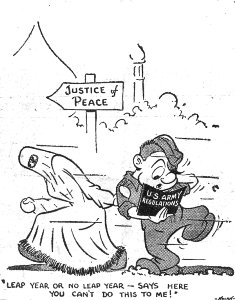
|
TWO NIGHT RAIDS
In two night raids, the RAF attacked enemy positions in the Homalin area and a Jap camp east of the town, in the same district in which an enemy-held village had been set ablaze the day before. On the 16th, U.S. planes got three locomotives near Wunthu and attacked troops and supplies in the Kamaing, Walawbum, Lonkin and Myitkyina areas. On the 15th U.S. planes destroyed the Mu Canal railroad bridge at Ye-U and a nearby road bridge, and smashed freight cars and anti-aircraft positions.
A Jap base and motor convoy near Shingaban were heavily bombed and strafed, as were two other troop and supply concentrations in northern Burma on Feb. 14, and two large warehouses were destroyed just north of Mandalay. In the upper Chindwin area, RAF planes shot up a concentration of rafts and blasted Jap headquarters near Mawlalk.
MANDALAY STRUCK
Rail yards in the Mandalay area were heavily hit, as were the airfields at Myitnge, Heho and Anisakan. Two night sweeps by the RAF included such targets as Akyab, Prome, Henzada, Bassein, Rangoon, Moulmein, Thanbyuzayat, Kyunton and Bangkok, where rail centers were the principal targets. Toungoo airfield was also hit, and several bridges and storage areas were either destroyed or heavily damaged in the vicinity of Taungup.
Violent activity occurred over the Arykan and the Mayu Peninsula, where RAF, Indian Air Force, and U.S. planes attacked in support of land operations. The RAF accounted for five Jap planes confirmed and 10 damaged, while four more were damaged in other encounters. Allied losses amounted during the week to three planes.
Lip Ticklers Now in Fashion in China
CHINA - For units of the Flying Horse Group, it's evidently a long time between holidays. Half-way between our own and the Chinese New Year, the unit staged a double-barreled celebration of two important events. One was the second anniversary of its leaving Stateside, the other was the announcement that the old-timers may soon, a certain percentage each month, be going home.
While the "Assam Dragon" and "China's Flying Wall" Squadrons were observing the occasion, the latter with a hamburger fry, Headquarters and the "China Blitzer" Squadron were elsewhere partaking of a Red Cross-sponsored buffet supper. This was followed by informal talks by Col. S. B. Knowles, Jr., Group Commander, and squadron officers. After a program of mass singing and several impromtu and premeditated skits, the organized phase of the festivities were concluded with the reading of the Moustache Club Resolution. This decreed that all members of the group who have been two years overseas will immediately sprout a lip ornament (removable only on receipt of a trip ticket to the Zone of the Interior), and that any junior member so adorned will promptly shave.
So if you wander Chinawards and see some G.I. with a feeble effort where nature obviously intended he should be bare, don't laugh - he may be going home.
The C.B.I. Roundup is a weekly newspaper published by and for the men of the United States Army Forces in China, Burma, and India, from news and pictures supplied by staff members, soldier correspondents, the United Press, and the Army News Service. The Roundup is published Friday of each week and is printed by The Statesman in New Delhi, India. Editorial matter should be sent directly to Lt. Floyd Walter, Rear Echelon Hq., U.S.A.F., C.B.I., New Delhi, and should arrive not later than Monday in order to make that week's issue. Pictures must arrive by Sunday and must be negatives or enlargements. Stories should contain full name and organization of sender.

FEBRUARY 24, 1944
Original issue of C.B.I. Roundup shared by Virginia Dyer, widow of CBI veteran Stanley Dyer.
Photos of Lt. Schrader and F/O Kosteff were apparently swapped in the printing
process and have been placed with the proper story in this re-creation.
Copyright © 2014 Carl Warren Weidenburner
TOP OF PAGE PRINT THIS PAGE ABOUT THIS PAGE SEND COMMENTS
PREVIOUS ISSUE CLOSE THIS WINDOW NEXT ISSUE
